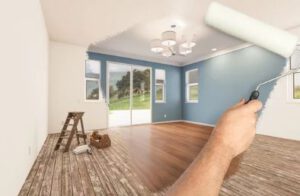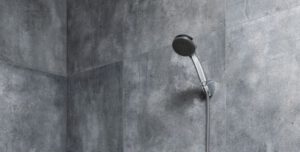Home » Articles posted by Harold Perry
Author Archives: Harold Perry
Paint Options For a Minimalist Home
Minimalists prioritize simplicity and elegance in their home design. Every element, from furniture to wall art, should work in concert to create a clean and harmonious aesthetic.
Paint is a crucial part of any space; the right shade can make or break the overall look, and painters can help you select the best color options for your minimalist home.

Minimalism focuses on embracing natural textures to create a fresh, clean aesthetic. Neutrals like white, blush, beige, and tan are key in these minimalist designs because they allow you to play with texture without overwhelming the space.
Light-colored paint makes rooms feel larger, essential for a minimal look. Opt for a cool white shade, such as Pure White, to maximize the openness of your home. To create a soft, airy color palette, combine this bright white with trim and ceiling colors in Balsam 567 or other neutral shades with warm undertones. It also offers a wide array of sheen options, so be sure to test a sample on your walls or trim to see how the finish looks in your space.
The lines in furniture and decor are another important element in minimalist design. Straighter lines are more visually appealing, and squared doorways instead of arched ones can give a room a clean, uncluttered appearance. Furniture with a modern or contemporary look is ideal for a minimalist home, and it’s important to avoid overly stuffed sofas and dated carved tables.
Minimalist design is about choosing only the things you truly love and need. Minimalists often decorate their homes with heirlooms, art, and other items that have meaning to them. However, it’s essential to keep the number of these items down so that your minimalist home doesn’t feel sterile or clinical.
Decorative accessories, such as lamps, throw pillows, and artwork, should all be kept to a minimum so your spaces feel comfortable. However, if you have a favorite painting that speaks to you, consider hanging it on one wall as a statement piece that adds personality to your minimalist home.
Another way to bring a touch of color into a minimalist home is through plants. Whether you place a single flower on a kitchen table or arrange a fern in the corner of your living room, plants are an easy way to add color while maintaining a minimalist style.
If you’re going for a minimalist home look, neutral colors are the way to go. Neutral shades like white, gray, beige, tan, and earth tones are the foundation of cool, simple designs that keep rooms looking spacious, uncluttered, and modern. Neutral colors can also be a great backdrop for pops of color and serve as a canvas for textural accents, such as wood furniture or woven baskets.
Light, soft neutrals like Agreeable Gray and Gray Owl can be the ideal backdrop for your minimalist decor. Both colors have warm undertones and can complement various coastal, contemporary, and traditional styles. However, they may look different depending on the lighting in your space and the flooring you choose. That’s why it’s important to see the paint colors in your home before committing. A quick and easy way to do this is with peel-and-stick samples.
Darker gray paint colors can also work well in a minimalist home but must be used carefully. Too much darkness can quickly overwhelm a room and make you feel claustrophobic. A good rule of thumb is one in, two out. For example, if you add a new piece of furniture with a darker finish, plan to remove an equal amount of more minimal items.
Lilac gray is another neutral that can work for a minimalist design. It’s a feminine color that adds warmth and balance to a room. It also pairs beautifully with wooden furniture and woven materials, creating a cozy, inviting space.
Adding texture to your minimalist design is a great way to elevate your decor and bring it to life. Rugs, blankets, pillows, and wooden surfaces are a few of my favorite ways to do this. But you can even use textural oil paintings to create an impactful statement. Whatever you do, be sure to avoid patterns and other busy elements that can detract from the clean lines of your design.
Modern minimalism emphasizes clean lines and crisp shapes, so beige paint options are great. Sand tones, tans, and shades of beige make for gorgeous wall colors that work well with minimalist home design. Like white, beige paints provide a neutral backdrop that makes accents and furniture pop, whether using the color in a monochromatic scheme or as a foundation for a colorful palette.
Beige paints also pair well with warm, earthy colors like rich reds, apricots, and browns. The key is to use these hues sparingly, as many colors can overwhelm a minimal space if used overzealously. Incorporate a few touches of these colors in a small area or on an accent wall, and be sure to balance them with plenty of white and gray tones throughout the rest of the room.
To find the perfect shade of beige, consider looking at a painted sample under different lighting conditions. The light in a store can be much different from the light in your home, impacting how each paint color looks. For example, a beige paint shade may look golden under certain lights and more yellow in another. Examine the paint sample at all times of day to see how the undertones change.
While beige is a neutral color, it still has unique undertones that give each shade personality. Some beige paints are softer and creamy, while others are earthy and sandy. Macrame beige is a soothing paint option that works best with bohemian decor, while beige has a slight hint of peach and can create a spa-like feel in any room.
Unlike white, beige paints can have warmer and cooler undertones, depending on their formula’s amount of yellow, blue, and red colorants. The same is true of every paint color, so analyzing the undertones and determining if they’re compatible with your design goals before purchasing is important.
When choosing paint colors for a minimalist space, it’s best to stick with soft, muted shades with a warm undertone. A few light coats of beige can make any room look bigger, which is ideal for a small or compact apartment or condo. Light colors can also help rooms feel more open and airy, a major component of minimalist style.
With the resurgence of all things retro, pastel pink is a beautiful and versatile color for minimalist homes. However, it is a challenging color to use in a large space or across all furniture, so it is best used as an accent element such as a pillow, lighting fixture, or living room carpet. These smaller elements are easy to swap out, allowing you to change your decor or even switch out the wall paint without making any permanent changes.
Minimalists prefer to work with neutral colors, but that doesn’t mean their homes need to be sterile and boring. Introducing a few focal points of decor, like eye-catching wall art or lush greenery, helps keep a minimal home feeling fresh and interesting. Minimalists also appreciate working with texture. Adding fabrics with different textures, such as faux fur, leather, wicker, and exposed wood grain, can help add interest to a neutral color palette.
Another way to keep a minimalist home from getting cluttered is to focus on multifunctional furniture and storage solutions. For example, a dining table that doubles as a console for entertainment gear or a bench with hidden storage underneath for items such as spare blankets and knick-knacks is an ideal way to keep your space clean and organized.
Lastly, minimalism is about eliminating unnecessary clutter and only keeping useful or sentimental pieces. Stacks of magazines, chewing gum packs, empty coffee cups, and old paintbrushes do not belong in a minimal home, so tuck these items in pretty bins and baskets, concealed in a storage cabinet or tucked into a closet.
Minimalists love to work with whites and soft grays, but they can also use deeper hues such as black, navy blue, or forest green to create a cocoon-like vibe in their spaces. They’re also comfortable using a monochromatic color scheme to add visual interest, as seen in this kitchen with rich Balsam 567 and a soft sheen on the cabinets. In addition, minimalists often utilize sheen selection to bring texture and depth to their rooms, as seen here with a matte finish on the walls and a satin sheen on the ceiling.
What You Should Know About Interior House Paint
If you have just purchased a new house or are re-doing the interior of your current one, you should know a few things before you begin. The types of paint you use should be chosen to protect your home and ensure that the paint job lasts for years
Preparation
Preparing your home for a good old-fashioned paint job isn’t just about picking up a can of paint. It’s about fixing up a few minor flaws first. For instance, a flexible sealant will do the trick if you have a gap in your door frame. Also, don’t forget to remove furniture and soft furnishings. You can even roll a rug on a piece of plastic if you need to. A tidy work area will help you get the job done faster and more easily.
Luckily, painting a house is an enjoyable pastime for most. The process is so rewarding that you will likely want to repeat it several times. To keep your spirits up, try to remember a few things.
Sheen
Interior house paint can be purchased in a variety of sheens. These sheens have different uses and benefits, so you should choose based on your room’s needs and personal preference. Some sheens are more durable, while others are easier to clean.
The sheen of the paint can help to create a beautiful finish on your walls. It will also affect how light is reflected and how the color looks. You can even use several sheens to create fun patterns and textures.
There are six main types of sheens. They include flat, eggshell, satin, semi-gloss, gloss and matte. Your choice will depend on the type of area you plan to paint, your overall vision for the room, and how you plan to maintain the finish.
Durability
When it comes to painting your house, the durability of your chosen paint is a big factor. It can make or break your project’s success. Getting it right can be expensive and time consuming. But a durable coat will not only protect the outer layers of your home, it will also help keep your walls looking great, even after several years.
The most durable paints come in two types. Water-based and oil-based. Water-based options are typically used in less trafficked areas, while oil-based varieties are better for high-traffic areas. Oil-based paints are more durable, but they can produce nasty fumes. If you’re unsure which is best for your project, consult a professional.
Sherwin Williams Emerald Urethane Trim Enamel
Sherwin Williams Emerald Urethane Trim Enamel is a high-quality cabinet paint that comes in a variety of colors. It has the ability to offer good color retention and can resist yellowing. Its water-based formula is easy to apply and has excellent blocking resistance.
The Sherwin Williams Emerald Urethane trim paint is available in satin, semi-gloss and gloss sheens. The newest addition to this family is a High Hide White base. These finishes are also self-leveling. As the enamel dries, the sheen will smooth out. This product is perfect for areas with heavy traffic.
The Emerald Urethane trim paint is also very durable. You can expect this paint to last for years. In fact, it is designed for doors and baseboards, which can handle the rigors of heavy traffic.
Oil-based vs water-based paints
The choice between oil-based and water-based house paints is an important one. Both have their own advantages and disadvantages. However, the right choice for your project will depend on the specific situation.
Oil-based paints are a traditional choice for decorators. They offer excellent resistance to wear and tear. These paints also produce a beautiful glass-smooth finish. Traditionally, these paints were used on all architectural projects, including interior walls. In recent years, however, a growing number of professional painters are choosing water-based alternatives.
Water-based paints are more flexible, but they can have an issue with cracking. They are less likely to emit harmful VOCs and have a lower odour. This means they can be used in spaces with good ventilation.
Eco-friendly paints
Eco-friendly interior house paints are available in a variety of colors and finishes. They can be water-based, or have a matte finish. Some paints use natural pigments, while others use synthetic dyes.
These paints are designed to have low volatile organic compounds, or VOCs, and no toxic biocides. The benefits of using eco-friendly paint include better health, easier cleaning, and better durability.
When choosing a low-VOC interior paint, make sure the formula is not manufactured with harsh chemicals, such as chlorine. You should also choose a brand that has a transparent ingredient list.
There are several eco-friendly house paints on the market, including ECOS Paint. This USA-made brand offers an expansive color selection, with no VOCs.
Shower Types to Consider When Remodeling Your Bathroom
When you’re planning to remodel your bathroom, there are many different shower types to consider. The walk-in shower is one of the most luxurious types of showers, and it can cost up to $6,000 or more. They are a great option for those who need easier access to the bathroom, and they are a beautiful addition to any larger bathroom. But, if space is at a premium, a shower stall is a great option. Shower stalls typically cost between $400 and $1,000. You can also choose to install a glass door to make the space appear larger.
The style of the shower is an important factor, as it will complement the rest of the bathroom decor. Choose a style that compliments the bathroom designs you like. You’ll want to consider how many people will use the shower and the water pressure. If you’re unsure about the shower’s size, you can always try a hand-held shower. These showers are also affordable and don’t require a hot water supply. They’re easy to install and adjust to your preferred temperature.
Another factor to consider is the cost of materials. While stone and marble are the most expensive options, fiberglass showers are less expensive. You can also opt for single-piece showers made of fiberglass or acrylic. These showers are easy to clean and tend to be less expensive than other options. While stone and tile showers are generally more expensive, they’re durable and waterproof. Plus, they’re easy to replace. They also come in a wide variety of finishes and colors.
The most common type of shower is the unvented water system. In this system, large amounts of water are stored under high pressure. A combination boiler provides the necessary heat, but there’s also the option for a gravity system where the water trickles down through gravity. A freestanding walk-in shower is also a popular choice because it’s spacious and eliminates the need for a bathtub. If you have a small bathroom, a shower with a large shower is probably not the best option.
Acrylic shower pans are also relatively inexpensive. While they’re not as durable as stone or tile, acrylic shower pans are easy to maintain. Because acrylic is made of large sheets of plastic or a silicone mold, these pans are easy to clean and don’t require the constant polishing of tiles. The downside to acrylic is the cost of repair. Because they’re not as easy to clean as fiberglass or acrylic, they can break or crack over time, but the aesthetic impact they produce is truly stunning.
While you can try to fit a custom shower yourself, most homeowners will need to hire a contractor. If you’re looking for a shower that’s perfect for your bathroom, a manual mixer shower is a good option. These showers use cold water and hot water to mix the two and ensure that you receive both types of water when showering. And, of course, you can always control the temperature and water pressure with a manual mixer shower.
If you’re a technology-savvy individual, digital showers are a great choice for you. They let you adjust the temperature and even display how much water you need. Plus, many digital showers can be controlled by a smartphone or remote control. These showers also have the advantage of being space-saving and stunning additions to your bathroom suite. You can even purchase a shower control unit for your home’s smart home system.
A concealed shower uses a water source hidden inside the ceiling of the shower. A concealed shower can maximize floor space, and many types of water flow are available. You can choose between rain, mist, and revolves to enhance your shower experience. Some even feature a built-in LED. And if you want a two-person shower, a concealed shower might be the way to go. When designing a bathroom, remember to consider the size of the space you have.
Electric showers are another popular option. The reason for this is the fact that they don’t store water and provide hot water on demand. Electric showers are also considered to be environmentally friendly since they only use a small amount of energy and never have to worry about running out of hot water. However, if you’re a heavy user of hot water, an electric shower might not be the best option for you. Aside from saving energy, electric showers are also easier to install and maintain a consistent temperature.